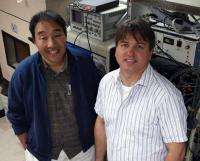Healthy ears hear the first sound, ignoring the echoes

Voices carry, reflect off objects and create echoes. Most people rarely hear the echoes; instead they only process the first sound received. For the hard of hearing, though, being in an acoustically challenging room can be a problem. For them, echoes carry. Ever listen to a lecture recorded in a large room?
That most people only process the first-arriving sound is not new. Physicist Joseph Henry, the first secretary of the Smithsonian Institution, noted it in 1849, dubbing it the precedence effect. Since then, classrooms, lecture halls and public-gathering places have been designed to reduce reverberating sounds. And scientists have been trying to identify a precise neural mechanism that shuts down trailing echoes.
In a new paper published in the Aug. 26 issue of the journal Neuron, University of Oregon scientists Brian S. Nelson, a postdoctoral researcher, and Terry T. Takahashi, professor of biology and member of the UO Institute of Neuroscience, suggest that the filtering process is really simple.
When a sound reaching the ear is loud enough, auditory neurons simply accept that sound and ignore subsequent reverberations, Takahashi said. "If someone were to call out your name from behind you, that caller's voice would reach your ears directly from his or her mouth, but those sound waves will also bounce off your computer monitor and arrive at your ears a little later and get mixed in with the direct sound. You aren't even aware of the echo."
Takahashi studies hearing in barn owls with the goal of understanding the fundamentals of sound processing so that future hearing aids, for example, might be developed. In studying how his owls hear, he usually relies on clicking sounds one at a time.
For the new study, funded by the National Institutes of Deafness and Communication Disorders, Nelson said: "We studied longer sounds, comparable in duration to many of the consonant sounds in human speech. As in previous studies, we showed that the sound that arrives first -- the direct sound -- evokes a neural and behavioral response that is similar to a single source. What makes our new study interesting is that the neural response to the reflection was not decreased in comparison to when two different sounds were presented."
The owls were subjected to two distinct sounds, direct and reflected, with the first-arriving sound causing neurons to discharge. "The owls' auditory neurons are very responsive to the leading edge of the peaks," said Takahashi, "and those leading edges in the echo are masked by the peak in the direct waveform that preceded it. The auditory cells therefore can't respond to the echo."
When the leading sound is not deep enough in modulation and more time passes between sounds, the single filtering process disappears and the owls respond to the sounds coming from different locations, the researchers noted.
The significance, Takahashi said, is that for more than 60 years researchers have sought a physiological mechanism that actively suppresses echoes. "Our results suggest that you might not need such a sophisticated system."














